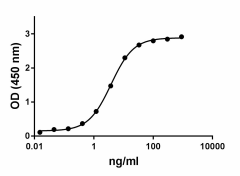- Regulatory Status
- RUO
- Other Names
- CD137, CDw137, 4-1BB, 4-1BB ligand receptor, T cell antigen ILA, T cell antigen 4-1BB homolog.

-

Human TNFRSF9 binds to immobilized TNFSF9 in a dose dependent manner. -
Stability testing for human TNFRSF9/ 4-1BB-Fc Chimera. Human TNFRSF9 was aliquoted in PBS, pH 7.2, 10% glycerol, at 0.2 mg/ml and one aliquot was kept at 4°C (control) and another was freeze-thawed four times (4 x freeze-thaws). After this procedure, the samples were tested by binding assay. Immobilized human recombinant TNFSF9, 100 µl at 0.5 µg/mL, binds recombinant human TNFRSF9 in a dose dependent manner.
| Cat # | Size | Price | Quantity Check Availability | ||
|---|---|---|---|---|---|
| 772602 | 10 µg | $94.00 | |||
| 772604 | 25 µg | $229.00 | |||
| 772606 | 100 µg | $680.00 | |||
| 772608 | 500 µg | $1992.00 | |||
Select size of product is eligible for a 40% discount! Promotion valid until December 31, 2024. Exclusions apply. To view full promotion terms and conditions or to contact your local BioLegend representative to receive a quote, visit our webpage.
TNFRSF9, also known as 4-1BB and CD137, is a member of the tumor necrosis factor receptor superfamily (TNFRSF). It is a costimulatory receptor similar to OX40, CD27, CD30, and CD40. The interaction of TNFRSF9 and its ligand, TNFSF9, leads to the activation of cytotoxic T cells, reactivation of anergic T lymphocytes, and induces T cell proliferation. TNFRSF9/TNFSF9 preferentially enhances the expansion of CD8+ T cells rather than CD4+ T cells, through the increase of IL-2Rα (CD25) and IL-2 expressions in CD8+ T cells. Among the TNFRSF members, TNFRSF9 is the most potent inducers of IL-2Rα expression on CD8+ T cells. In vivo studies with TNFSF9 knockout mice and with the agonistic anti-TNFRSF9 monoclonal antibody showed that TNFRSF9/TNFSF9 interaction keeps optimal CD8 T-cell mediated immune response against viral infections and tumors. The mouse TNFRSF9 has 60% identity to the human receptor at the amino acid level.
Product Details
- Source
- Human TNFRSF9, amino acid Leu24-Gln186 (accession # Q07011), with a linker and a C-terminal human Fc-6His-tag, was expressed in 293E cells.
- Molecular Mass
- The 402 amino acid recombinant protein has a predicted molecular mass of approximately 44.29kD. The DTT-reduced and non-reduced protein migrates at approximately 60 and 110 kD respectively by SDS-PAGE. The predicted N-terminal amino acid is Leu.
- Purity
- > 95%, as determined by Coomassie stained SDS-PAGE.
- Formulation
- 0.22 µm filtered protein solution is in PBS pH 7.2, 10% glycerol.
- Endotoxin Level
- Less than 0.1 EU/µg cytokine as determined by the LAL method.
- Concentration
- 10 and 25 µg sizes are bottled at 200 µg/mL. 100 µg size and larger sizes are lot-specific and bottled at the concentration indicated on the vial. To obtain lot-specific concentration and expiration, please enter the lot number in our Certificate of Analysis online tool.
- Storage & Handling
- Unopened vial can be stored between 2°C and 8°C for up to 2 weeks, at -20°C for up to six months, or at -70°C or colder until the expiration date. For maximum results, quick spin vial prior to opening. The protein can be aliquoted and stored at -20°C or colder. Stock solutions can also be prepared at 50 - 100 µg/mL in appropriate sterile buffer, carrier protein such as 0.2 - 1% BSA or HSA can be added when preparing the stock solution. Aliquots can be stored between 2°C and 8°C for up to one week and stored at -20°C or colder for up to 3 months. Avoid repeated freeze/thaw cycles.
- Activity
- When human TNFSF9 (Cat. No. 750002) is immobilized at 0.5 μg/ml (100 μl/well), human TNFRSF9 binds with EC50 = 2 - 10 ng/ml in a functional ELISA.
- Application
-
Bioassay
- Application Notes
-
BioLegend carrier-free recombinant proteins provided in liquid format are shipped on blue-ice. Our comparison testing data indicates that when handled and stored as recommended, the liquid format has equal or better stability and shelf-life compared to commercially available lyophilized proteins after reconstitution. Our liquid proteins are verified in-house to maintain activity after shipping on blue ice and are backed by our 100% satisfaction guarantee. If you have any concerns, contact us at tech@biolegend.com.
Antigen Details
- Structure
- Dimer
- Distribution
-
Activated T cells, natural killer cells, macrophages, neutrophils, dendritic cells, eosinophils, Tregs, activated B cells, mast cells, and endothelial cells in tumor capillaries.
- Function
- Proliferation of T cells, activates their effector functions, survival, and establishes immunological memory.
- Interaction
- Activated antigen presenting cells, macrophages, B cells, B cell lymphoma, dendritic cells, a small fraction of T cells, epithelial, and endothelial cells.
- Ligand/Receptor
- TNFSF9 and CD137L
- Bioactivity
- Human TNFRSF9 binds to immobilized TNFSF9
- Biology Area
- Immunology
- Molecular Family
- CD Molecules, Immune Checkpoint Receptors, Soluble Receptors
- Antigen References
-
- Pollok KE, et al. 1994. Eur. J. Immunol. 24:367.
- Watts TH. 2005. Annu. Rev. Immunol. 23:23-68.
- Zhu Y, et al. 2007. Blood 109:4882.
- Locatelli F. 2009. Blood 11:2208.
- Wang J, et al. 2010. J. Immunol. 185:7654.
- Eun SY, et al. 2015. J. Immunol. 1:134-41.
- Spencer AJ, et al. 2014. PLoS One. 9:e105520.
- Yi L, et al. 2014. PLoS One 1:e86337.
- Gene ID
- 3604 View all products for this Gene ID
- UniProt
- View information about TNFRSF9 on UniProt.org

